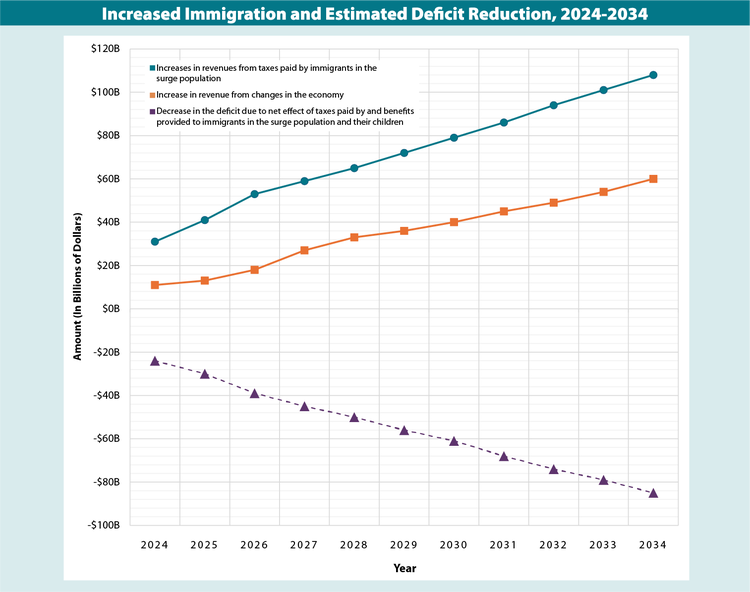
The question of whether immigration represents a net cost or a net benefit to the U.S. economy has been a major source of contention, even as the research literature and thinking among economists has been quite clear. Sifting through the full economic and fiscal impacts of immigration is a complex task, but a strong body of research and consensus by most economists finds that immigration, on balance, is a net positive for the U.S. economy. Still, the public debate over economic impacts continues, as some observers highlight immigrants’ tax payments and labor force contributions, while others underscore education, health care, and other costs to governments.
Overall Economic Growth and Impacts
Immigrants boost overall economic growth by expanding the labor force and increasing consumer spending.The foreign born also start new businesses at higher rates than U.S.-born individuals. Immigrants were involved in the development of 30 percent of patents in strategic industries in recent years, and more than 40 percent of Fortune 500 companies were founded by immigrants.
Higher-than-expected immigration is driving job growth and productivity and is projected to continue doing so in the coming years: The Congressional Budget Office (CBO) estimates that the greater level of immigration expected between 2024 and 2034 will boost gross domestic product (GDP) by $8.9 trillion.

Fiscal Impacts: Do Immigrants Contribute More to Governments than They Cost?
While immigrants—like U.S.-born individuals—cost governments money for services such as public education, health care, basic infrastructure such as sewer systems and roads, and sometimes public benefits, they also pay into government budgets through sales taxes; property taxes (either directly as homeowners or indirectly through rent payments); and through payroll deductions, taxes on income as well as for Medicare and Social Security. Even unauthorized immigrants who lack work authorization pay these taxes: on top of sales and property taxes, many work on the books using a fake Social Security number or one belonging to another worker, and as a result pay payroll taxes.
On balance, do these payments exceed the government spending that immigrants receive? At the federal level, immigrants pay more in taxes over time than they use in government services and benefits, according to a landmark report by the National Academy of Sciences and a range of more recent studies. The picture is different at the state and local level. Immigrants tend to cost local governments more than they pay in, primarily due to the cost of their children’s public schooling.
Labor Force Growth
Immigration has been the major driving force behind U.S. labor force growth over the past 20 years, according to data from the U.S. Census Bureau. Between 2000 and 2022, the foreign born accounted for nearly three-quarters of all growth in the civilian, prime-age (age 25 to 54) labor force. As the U.S. population ages and more U.S.-born residents enter retirement, immigration will become increasingly important for driving labor force growth. Due to population aging, the number of U.S.-born people of prime working age (age 25-54) hardly changed between 2000 and 2022. In contrast, the number of foreign-born people of prime working age grew by almost 7 million over this period. And the U.S.-born senior population (age 65 and older) grew by almost 18 million over the same timeframe.

This trend will only accelerate in the future. By one estimate, all U.S. population growth will come from international migration starting in 2040.
Efforts to boost fertility, as an alternative to immigration, are unlikely to be sufficient. Around the world, government efforts to raise fertility through economic incentives or family-friendly policies have a mixed record of success.
Do Immigrants Take Jobs from U.S. Workers?
While immigration skeptics have charged that immigrants take jobs from the U.S. born, in particular Black workers, the evidence demonstrates that immigrants have taken a larger slice of a growing jobs pie over recent decades rather than displacing American workers.
The number of U.S. jobs is not fixed: In addition to filling jobs, immigrants also foster job growth by consuming goods and services and by starting businesses.
Further, when employers hire immigrants, they often do so to fill critical positions that enable them to expand operations and hire more workers, including U.S.-born workers. For example, if a chip manufacturer is able to hire more highly specialized computer scientists from abroad, they can expand overall operations and hire more U.S.-born workers to fill technician, sales, accounting, and other roles.
Because immigrants are more likely to appear both at the higher and lower ends of the educational spectrum than the U.S. born, they often fill jobs that complement those held by U.S.-born workers. Some immigrants have skills that most U.S. workers lack (specialized engineering skills, for example), while others fill jobs that are not attractive to U.S. workers because of the wages or working conditions (for example, in agriculture or roofing).

The U.S. workers who face the most direct competition from immigrants are those without high school diplomas, including other immigrants who came earlier. Those workers are most likely to see their wages lowered by immigration. But these wage effects are small, with most studies finding that immigration results in wage declines of just a few percentage points or no wage effects at all.
While the costs of immigration to local governments and to less-educated U.S. workers should not be discounted, immigrants on balance are net contributors to the U.S. economy when considering their contributions to the labor market, to overall economic growth, and to government coffers.
Resources
- National Academies of Sciences, Engineering, Medicine, The Economic and Fiscal Consequences of Immigration, 2017.
- Congressional Budget Office, Effects of the Immigration Surge on the Federal Budget and the Economy, April 2024.
- Federal Reserve Bank of Dallas, Unprecedented U.S. Immigration Surge Boosts Job Growth, Output, July 2024.
- TIME magazine, Immigration Is Powering the U.S. Economy, April 2024.
- Migration Policy Institute, Beyond the “Black Jobs” Controversy: Immigrants and U.S.-Born Black Workers Share a Growing Jobs Pie, August 2024.
Download Explainer
Please visit:
Our Sponsor
